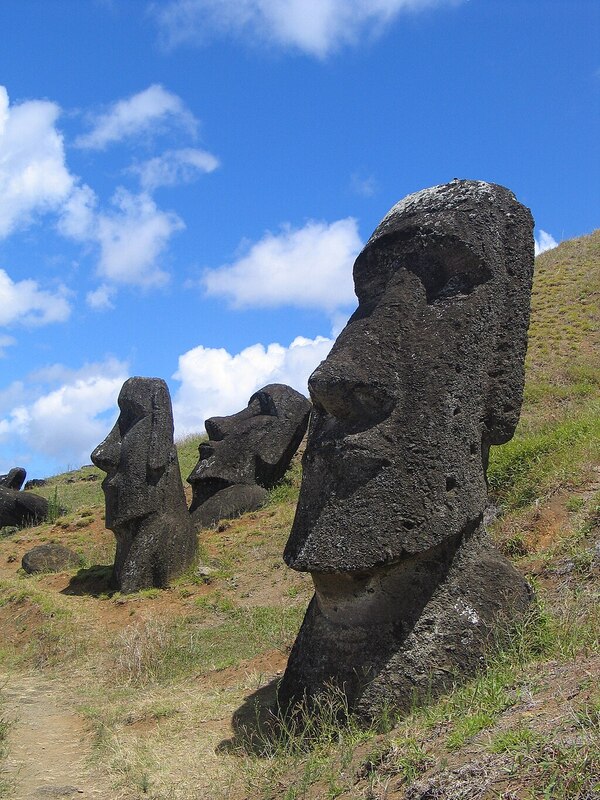You Can't Handle the Truthiness
By Alan Dove
In 2005, Pulitzer-winning anthropologist and author Jared Diamond published Collapse, an extensive study of different human societies that have fallen apart across history. One of the most striking cases Diamond described in the book was that of Easter Island or Rapa Nui, whose first human civilization had collapsed, according to Diamond, entirely from “ecocide.” The short version is that the first humans to arrive there from Polynesia built an elaborate society atop unsustainable harvesting of the island’s trees. When they ran out of trees, they couldn’t build large vessels to fish far offshore anymore, and couldn’t escape the island either. As a result, the population crashed and the people fell to fighting and eating each other.
It’s a great story, and one perfectly attuned to the environmental concerns of our 21st century world, where unsustainable consumption is causing planet-wide damage that shows no signs of slowing. The lesson was clear: all of humanity is now on a path toward the same sort of tragic collapse suffered by the indigenous people of Rapa Nui.
There’s just one problem: Diamond’s version of Easter Island’s history is almost certainly wrong. I don’t mean there are some niggling details he missed, I mean the whole ecocide theory is absolute bullshit. It contradicts nearly all of the physical, anthropological, and historical evidence, as detailed in a book-length rebuttal published by a team of researchers the following year. More recently, genomic data put yet another stake through the heart of Diamond’s theory, revealing that the telltale genetic bottleneck we’d expect from such a collapse doesn’t appear at all in the genomes of the original settlers’ descendants.
 Still standing.
Still standing.
So how did a scholar of Diamond’s brilliance reach such a deeply flawed conclusion? I think he simply fell into the most insidious trap of nonfiction writing: following the story instead of the data. As I’ve said and written before, narrative is the essential currency of the human mind, and as such it’s immensely powerful. We structure our understanding of the world around stories; they’re how we make sense of a universe that fundamentally defies it. Indeed, the entirety of human experience is a collection of stories we’ve imposed on reality.
If we stick to “just the facts,” we have a pile of unrelated observations. Explaining them requires a structure: a story. That means picking which data points to emphasize, what order to put them in, and what to leave out. It’s hard, but with practice it gets easier, and for even moderately skilled writers what emerges is usually a decent facsimile of the truth. Diamond has certainly managed to do it well over the years, and I want to emphasize that the Easter Island chapter of Collapse is only one part of a much larger body of work, much of which has stood up.
Nor is this an isolated case of one guy confusing his preferred narrative with reality, it just provides one of the clearest-cut cases of the phenomenon. Indeed, the entire scientific method is, in a sense, just a detailed protocol for avoiding this specific mistake. We do experiment after experiment, control after control, trying to smash our favorite stories into smithereens. Only when we, and our colleagues and competitors, have all failed to disprove something do we say, cautiously, that it might be true.
Outside of a few fields, though, we can’t do such diligent experiments. Then what appears to be an orderly process, writing a true account of something, can run afoul of the alchemy going on at its core. Like someone using a Ouija board, the writer is simultaneously touching a real thing and thinking about the story it might tell. Sometimes, what comes out reflects the writer’s own preferences and beliefs more than the spirit of the facts. The story that feels right may not be.
For a thoughtful, big-picture nonfiction author living in a world where ecosystem destruction and unsustainable industrial practices are real, well-proven, pressing problems, a few tantalizing clues would’ve been enough to make the ecocide hypothesis for Easter Island’s history ring true. And let’s be clear, evaluated strictly in narrative terms, it’s a great story. It has heroes, villains, entirely believable conflicts, and a powerful moral argument with direct relevance to our own time. When a story like that pops out of the writing process, it’s nigh impossible to resist. Emphasize this data point instead of that one, ignore a couple of inconvenient findings that could threaten this wonderful story, and send it to press.
It’s probably a coincidence that the year Collapse came out is the same year a comedian named Stephen Colbert coined the term “truthiness,” to describe things that seem true - maybe even ought to be true, but aren’t. Diamond set out to tell the truth and got it wrong. Colbert set out to make a joke and touched a profound truth. Therein lies the central irony of stories; they’re the only way we have to see the world clearly, and also the fastest way to blind ourselves to it.